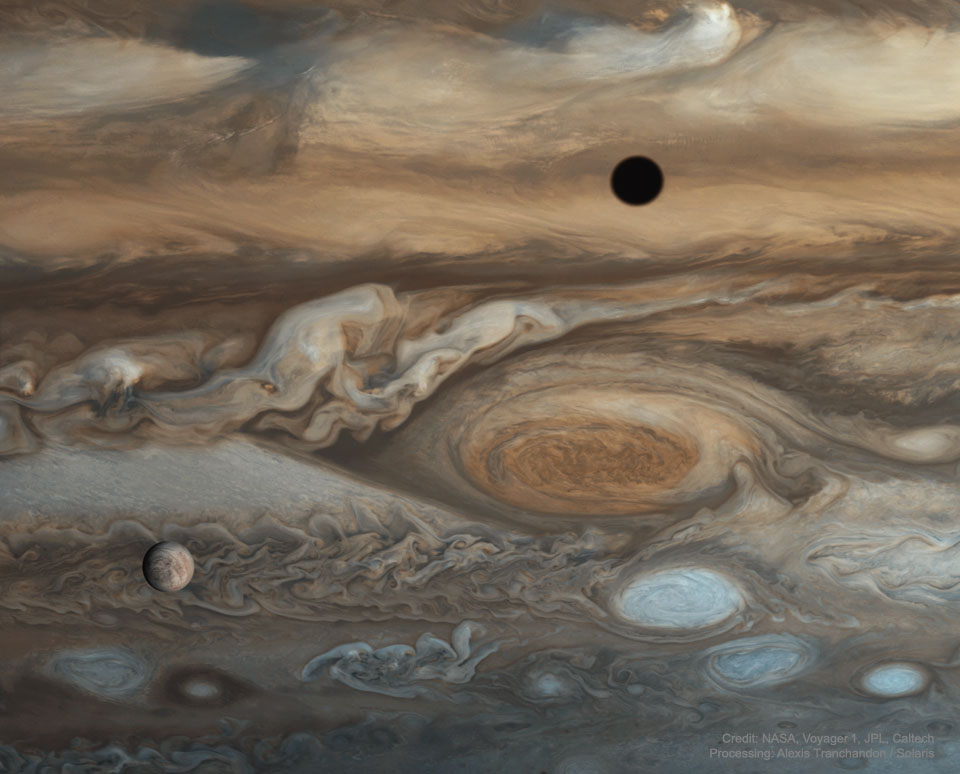17. July 2022
航海家 1 號 翕 ê 木衛二 Europa kah 木星

探索宇宙1!逐工會揀一幅無仝款 ê 影像抑是相片,𤆬你熟似咱這个迷人 ê 宇宙,閣有專業天文學者2為你3解說4。
- 原始文章:Europa and Jupiter from Voyager 1
- 影像來源:NASA, Voyager 1, JPL, Caltech; 資料處理 kah 許可:_ Alexis Tranchandon / Solaris
- 免費下載:航海家太空船海報
- 台文翻譯:An-Li Tsai (NCU)
[漢羅] 航海家 1 號 翕--ê 木衛二 Europa kah 木星
木星頂懸這寡圓點是啥物? 中央倚正爿上大--ê,是上大上遠 ê 大紅斑,是一个 tī 木星 頂懸使性地 ê 風暴系統。 這个風暴系統,Giovanni Cassini tī 357 冬前 就有注意著。 咱這馬猶毋知是按怎 大紅斑是紅色--ê。 倒爿下跤這粒,是木星上大粒 ê 月娘:木衛二 Europa。 這張是 航海家太空船 tī 1979 年翕--ê。 相片支持現代 ê 假說,講,木衛二 Europa 有一个地下海洋,所以遐是一个 揣外星生物 ê 好所在。 毋閣正爿頂懸彼个大 烏點 是啥物? 彼是另外一粒木星衛星,木衛一 Io ê 烏影:。 航海家 1 號發現講,木衛一 Io 有足濟火山活動,所以咱 tī 伊頂懸揣袂著 隕石坑。 航海家 1 號 tī 1979 年 ê 時陣飛過木星,翕著 16 張相片。 這馬有人 kā 這寡觀測資料重新處理,合併做 這張影像。 45 冬前 ê 8 月,航海家 1 號 ùi 地球發射,開始 tī 咱 太陽系 內底進行 上偉大 ê 探險 ,一直到今。
[POJ] Hâng-hái-kā 1 hō hip--ê Bo̍k-ūi-jī Europa kah Bo̍k-chhiⁿ
Bo̍k-chhiⁿ téng-koân chit-kóa îⁿ-tiàm sī siáⁿ-mih? Tiong-ng óa chiàⁿ-pêng siōng tōa--ê, sī siōng tōa siōng hn̄g ê Tōa-âng-pan, sī chi̍t-ê tī Bo̍k-chhiⁿ téng-koân sái-sèng-tē ê hong-pō hē-thóng. Chit-ê hong-pō hē-thóng, Giovanni Cassini tī 357 tang chêng to̍h ū chù-ì tio̍h. Lán chit-má iáu m̄-chai sī án-ná Tōa-âng-pan sī âng-sek--ê. Tē-pêng ē-kha chi̍t-lia̍p, sī Bo̍k-chhiⁿ siōng tōa-lia̍p ê goe̍h-niû: Bo̍k-ūi-jī Europa. Chit-tiuⁿ sī Hâng-hái-kā thài-khong-chûn tī 1979 nî hip--ê. Siòng-phìⁿ chi-chhî hiān-tāi ê ká-soat, kóng, Bo̍k-ūi-jī Europa ū chi̍t-ê tē-hā hái-iûⁿ, só͘-í hiah sī chi̍t-ê chhōe gōa-chhiⁿ seng-bu̍t ê hó-só͘-chāi. M̄-koh chiàⁿ-pêng téng-koân hit-ê tōa o͘-tiám sī siáⁿ-mih? He sī lēng-gōa chi̍t-lia̍p Bo̍k-chhiⁿ ūi-chhiⁿ, Bo̍k-ūi-it Io ê o͘-iáⁿ. Hâng-hái-kā 1 hō hoat-hiān kóng, Bo̍k-ūi-it Io ū chiok-chōe hóe-soaⁿ oa̍h-tōng, só͘-í lán tī i téng-koân chhōe bōe-tio̍h ún-se̍k-kheⁿ. Hâng-hái-kā 1 hō tī 1979 nî ê sî-chūn poe kòe Bo̍k-chhiⁿ, hip-tio̍h 16 tiuⁿ siòng-phìⁿ. Chit-má ū lâng kā chit-kóa koan-chhek chu-liāu tiông-sin chhú-lí, ha̍p-pèng chò chit-tiuⁿ iáⁿ-siōng. 45 tang chêng ê 8 goe̍h, Hâng-hái-kā 1 hō ùi Tē-kiû hoat-siā, khai-sí tī lán Thài-iông-hē lāi-té chìn-hêng siōng úi-tāi ê thàm-hiám, it-ti̍t kàu-taⁿ.
[KIP] Hâng-hái-kā 1 hō hip--ê Bo̍k-uī-jī Europa kah Bo̍k-tshinn
Bo̍k-tshinn tíng-kuân tsit-kuá înn-tiàm sī siánn-mih? Tiong-ng uá tsiànn-pîng siōng tuā--ê, sī siōng tuā siōng hn̄g ê Tuā-âng-pan, sī tsi̍t-ê tī Bo̍k-tshinn tíng-kuân sái-sìng-tē ê hong-pō hē-thóng. Tsit-ê hong-pō hē-thóng, Giovanni Cassini tī 357 tang tsîng to̍h ū tsù-ì tio̍h. Lán tsit-má iáu m̄-tsai sī án-ná Tuā-âng-pan sī âng-sik--ê. Tē-pîng ē-kha tsi̍t-lia̍p, sī Bo̍k-tshinn siōng tuā-lia̍p ê gue̍h-niû: Bo̍k-uī-jī Europa. Tsit-tiunn sī Hâng-hái-kā thài-khong-tsûn tī 1979 nî hip--ê. Siòng-phìnn tsi-tshî hiān-tāi ê ká-suat, kóng, Bo̍k-uī-jī Europa ū tsi̍t-ê tē-hā hái-iûnn, sóo-í hiah sī tsi̍t-ê tshuē guā-tshinn sing-bu̍t ê hó-sóo-tsāi. M̄-koh tsiànn-pîng tíng-kuân hit-ê tuā oo-tiám sī siánn-mih? He sī līng-guā tsi̍t-lia̍p Bo̍k-tshinn uī-tshinn, Bo̍k-uī-it Io ê oo-iánn. Hâng-hái-kā 1 hō huat-hiān kóng, Bo̍k-uī-it Io ū tsiok-tsuē hué-suann ua̍h-tōng, sóo-í lán tī i tíng-kuân tshuē buē-tio̍h ún-si̍k-khenn. Hâng-hái-kā 1 hō tī 1979 nî ê sî-tsūn pue kuè Bo̍k-tshinn, hip-tio̍h 16 tiunn siòng-phìnn. Tsit-má ū lâng kā tsit-kuá kuan-tshik tsu-liāu tiông-sin tshú-lí, ha̍p-pìng tsò tsit-tiunn iánn-siōng. 45 tang tsîng ê 8 gue̍h, Hâng-hái-kā 1 hō uì Tē-kiû huat-siā, khai-sí tī lán Thài-iông-hē lāi-té tsìn-hîng siōng uí-tāi ê thàm-hiám, it-ti̍t kàu-tann.
[English] Europa and Jupiter from Voyager 1
What are those spots on Jupiter? Largest and furthest, just right of center, is the Great Red Spot -- a huge storm system that has been raging on Jupiter possibly since Giovanni Cassini's likely notation of it 357 years ago. It is not yet known why this Great Spot is red. The spot toward the lower left is one of Jupiter's largest moons: Europa. Images from Voyager in 1979 bolster the modern hypothesis that Europa has an underground ocean and is therefore a good place to look for extraterrestrial life. But what about the dark spot on the upper right? That is a shadow of another of Jupiter's large moons: Io. Voyager 1 discovered Io to be so volcanic that no impact craters could be found. Sixteen frames from Voyager 1's flyby of Jupiter in 1979 were recently reprocessed and merged to create the featured image. Forty-five years ago this August, Voyager 1 launched from Earth and started one of the greatest explorations of the Solar System ever.
詞彙學習
| 漢羅 | POJ | KIP | 華語 | English |
|---|---|---|---|---|
| 航海家 1 號 | Hâng-hái-ka it hō | Hâng-hái-ka it hō | 航海家 1 號 | Voyager 1 |
| 木衛二 Europa | Bo̍k-ūi-jī Europa | Bo̍k-uī-jī Europa | 木衛二歐羅巴 | Europa |
| 大紅斑 | tōa-âng-pan | tuā-âng-pan | 大紅斑 | Great Red Spot |
| 木衛一 Io | Bo̍k-ūi-it Io | Bo̍k-uī-it Io | 木衛一埃歐 | Io |
| 木星 | Bo̍k-chhiⁿ | Bo̍k-tshinn | 木星 | Jupiter |
| 外星生物 | gōa-chhiⁿ seng-bu̍t | guā-tshinn sing-bu̍t | 外星生物 | extraterrestrial life |